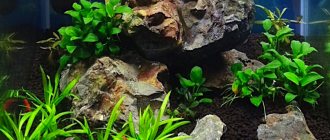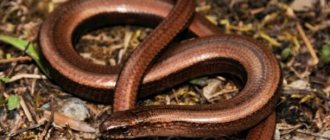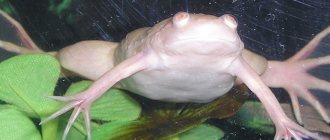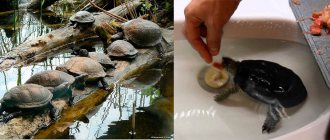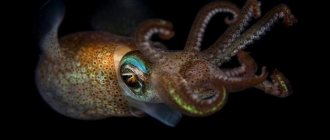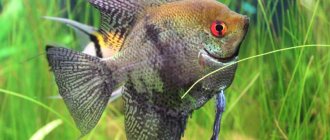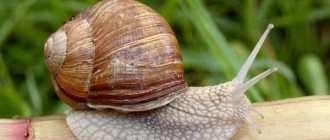What animals are kept in houses and apartments? Yes, any! If only they fit in size. It is clear that keeping a crocodile or alligator even in the bathroom will be problematic. But smaller amphibians - newts - are quite possible. They, like praying mantises (do you already know how to keep them at home?), will decorate your home, and you won’t be bored with them.
In our today's post about newts, we will tell you (and show in the photo their different types) how to keep such interesting animals at home (in an apartment). We will answer many questions that arise before people want to keep these amphibians at home:
- types of newts
that can be kept at home; - Is it possible to keep a newt with aquarium fish and other living creatures?
- How long
do house newts grow? - how to prepare an aquarium for a newt
; - what to feed a newt
at home; - useful tips for breeding newts.
Everywhere on planet Earth, wherever there are warm bodies of water, newts live. Of course, water newts, biological relatives of salamanders, are protected by law, but ordinary species can be bred at home. Caring for them is not difficult and they live at home with proper care for about 30 years.
There are a huge number of species of these amphibians, but not all members of the family can be kept in aquaterrariums. One of them, small (9 - 10 cm), is the common newt.
Newt in the aquarium
Newts are found in different parts of the world. Their population declines every year, so they often become inhabitants of aquaterrariums, including home ones.
These salamanders attract people with their unusual and beautiful appearance. They have an unusual color, which depends on the type of individual. A distinctive feature of the salamander is two longitudinal stripes on the head that end in the eye area. The amphibian has smooth skin and a long tail. The tail occupies more than half of the body. The amphibian has four legs with prehensile webbed toes. Thanks to this structure, the amphibian feels comfortable in water and on land. Salamanders grow up to 30 cm in length.
Habitat
In nature, newts choose areas where deciduous trees grow and forests are located near bodies of water. Amphibians overwinter in fallen leaves or in burrows, that is, on land, and the rest of the time amphibians live in water. In this case, the water area should be without a strong current or have standing water, for example, a pond or lake.
You can often meet amphibians in city parks, rural areas near residential buildings and summer cottages where there is a body of water nearby. The designated salamander species does not live in wetlands. The fact is that although such a plot of territory has a humid environment, it does not have the required amount of oxygen.
Attention!
In their natural habitat, newts often live for about 10-14 years. When kept in aquarium conditions, amphibians can reach 30 years of age.
One of the most amazing abilities of newts is the regeneration of lost body parts.
Kinds
More than 10 varieties are intended for aquarium keeping. The most common salamanders for aquarium keeping:
- ordinary;
- spiny;
- comb;
- red-bellied.
Ordinary
This is a classic amphibian with an olive back and a yellow belly. The common newt grows up to 12 cm in length. The scattering of yellow dots throughout the body makes the appearance unusual. Three lines stand out on the head, reaching to eye level.
Spiny
This is an amphibian that can grow up to 30 cm in length. Spiny salamanders are distinguished by thin ribs protruding from the sides of their bellies that resemble small needles. The salamander releases its needles in times of danger or under severe stress. At rest, the amphibian has a smooth body. The spiny newt is green, the abdomen is colored yellow. The body is decorated with a scattering of black specks.
Comb
This is a representative of medium size. Individuals grow up to 18 cm in length. Color can range from dark brown to black. The abdomen stands out brightly against a dark background; it is colored fiery orange. There are small dark spots on the abdomen. At the moment of danger, the crested amphibian releases dangerous poison, so experts recommend extreme caution when raising representatives of the breed at home.
Red-bellied
The smallest representative of the amphibian. The second name “red newt” received due to its bright red abdomen with dark spots. This is one of the most popular species for home keeping because it is unpretentious. The red newt can live in polluted water at high temperatures and does not show aggression towards other representatives of aquatic fauna.
Why are they so loved by so many?
Common newt
Common newt does not look like a fish. It does not have that softness, vulnerability and touching, like delicate fish surrounded by openwork fins and a luxurious tail.
This is a characteristic and colorful creature, similar to a salamander, and is represented in nature by several variants, each of which has only its own characteristics.
The species of these reptiles can differ significantly from each other in:
- sizes;
- coloring;
- required living conditions;
- character.
Captivity
For amphibians, you need to equip an aquaterrarium - an aquarium with islands of land. Basic requirements for designing an aquarium for an amphibian:
- capacity: the tank must be horizontal, elongated, to contain 20-30 liters of water;
- temperature regime: this is a cold-blooded amphibian, so the temperature in the terrarium should not exceed 22 degrees, with the exception of the red newt, which lives at elevated temperatures;
- acid balance level: it is necessary to monitor acidity levels, adjusting the balance to 5.5-7.8 PH;
- lighting: you cannot place incandescent lamps in the terrarium, as they increase the temperature; it is recommended to buy fluorescent lamps;
- ground cover: an amphibian can inadvertently swallow small elements, so the soil particles should not be smaller than the pet’s head;
- decor: the aquarium should have at least 20-30 liters. waters and islands of land where the amphibian can rest; Elements with sharp edges cannot be used for decoration;
- vegetation: you can plant live aquatic plants in an aquarium for newts; female amphibians use them to wrap eggs;
- filter device: for normal life, you can install an internal filter without aeration.
Once a week you should do a 20% water change. In summer, it is recommended to reduce the water temperature in the aquarium.
HomePeace
Among aquatic pets, fish and turtles are especially popular. Few people even think about owning amphibians like newts. The common newt as a pet will appeal to those who, due to their busy schedule, do not have the opportunity to feed, regularly walk, wash their pet, or pay attention to it every day. Caring for the common newt is very simple and does not require any special expenses.
Unusual pets are increasingly appearing in the apartments of people who want to add some exoticism and originality to their lives. One of these animals is the newt, an amphibian that looks like a lizard. Newts are relatives of salamanders and live both in water and on land. One of the types of newts is called Spanish, or spiny, this species is more common in nature, is unpretentious to living conditions and is recommended for keeping at home.
Varieties of newts
There are more than 10 different types of newts kept at home, but three of them are the most popular:
1. Common newt
2. Spiny newt , also known as Spanish newt
3. Crested newt
The Spanish newt is most often kept in aquariums. These animals are small. Their body length does not exceed eight centimeters, plus about the same tail. The color is dark brown, sometimes with bright yellow or orange stripes on the back or belly. Noticeable differences between males and females are observed only during the mating season. To recognize the species of your pet, look at this article: Varieties of aquarium newts
Content
What type of aquarium is needed?
For keeping 1-2 amphibians, a 15-20-liter aquarium , which after purchase must be thoroughly washed with a sponge and soap, then rinsed. If you live in a private house and have a well, you can use water for filling without settling it. If we talk about a city apartment, then the water must be settled for at least 48 hours. Therefore, in the latter case, water for replacement should be prepared in advance. When filling the aquarium, it is advisable to leave 5-10 cm free of water. As it emerges, the newt swallows air from the surface.
Any stones slightly larger than an amphibian's head will be suitable for soil It is important that they are not sharp or too small, otherwise the animal may be injured or swallow a stone. It is better to put the soil in the aquarium in a large size, with rounded and smooth edges. You can spread a thin layer of soil both along the entire bottom and near the home, leaving the feeding area clean.
Don't forget about the islands
Since in nature newts, when coming onto land, hide under bark or driftwood, the aquarium can also have a decorative log where the amphibian can feel protected.
An excellent solution would be to install a small shelter house in the aquarium. A house for a newt must have a lid, so you should come to terms with the fact that most of the daytime your underwater friend will be hidden from human eyes.
An aquaterrarium or an improved regular aquarium with a volume of at least 30 liters can be used as a newt habitat. Newts need dry islands for rest; for this, stones or boards can be placed in the aquarium, which form areas of land for the amphibian to stay.
Filter, plants and lighting
As practice shows, these animals are indifferent to plants , but they are still necessary: during the breeding season, females attach eggs to the leaves. An artificial plant with leaves will do just fine.
A filter is not necessary, but if you want, you can use a small one periodically. Newts do not like strong currents, but standing water spoils faster. If the filter has a power adjustment, set it to minimum. In addition, you should change a certain amount of water daily, all this will help prevent newt diseases, possible due to the decomposition of food debris and waste products. More on this below.
Lamps that do not heat the water are used for lighting Although pets feel comfortable without additional lighting.
Water temperature
The water temperature, measured with a thermometer, should be 15-22 degrees, which is slightly lower than in a regular aquarium. The water temperature for a newt should not exceed +22 C. Exceeding this norm will cause serious harm to the pet. If the ambient temperature is very high, the water can be cooled with ice.
Newt care
How to change water?
If, when purchasing an amphibian, a small aquarium was purchased for transportation, then it can be used for holding during water changes. Or adapt a container for these purposes, perhaps a deeper basin, so that the animals cannot crawl out. Having a net or pump for pumping out water is not necessary, but they make the process much easier. Having filled the container prepared for the amphibian with water of 15-22 degrees, move the newt from the main aquarium into it using a net. This method is best for beginners.
This procedure can be done by hand. It is necessary to wash them thoroughly with soap and rinse with cold water without wiping. The colder your hands are, the better. With a slow, confident movement, take the amphibian by the tail or place it in your palm and place it in a holding container. Unnecessarily, the animal should not be touched with hands, especially with warm hands, to avoid burns and overheating.
After this, pump out the water using a pump or ladle. Place the decorations in a basin. Wash the aquarium with the stiff side of a new dish sponge, with or without soap, paying special attention to the corners. Rinse thoroughly with running water using a shower head.
Rinse the decorations, as well as the soil, rubbing it between your palms. Rinse the stones first with hot water and then with cold water. Place in a clean container. Rinse the filter.
Fill the aquarium with water at the desired temperature, place decorations and transfer the amphibians back using the methods described above.
Feeding
How and what to feed newts?
For feeding you will need:
- knife;
- saucer;
- plastic tweezers (can be purchased at any optician).
In nature, the amphibian feeds on the larvae of various insects or earthworms. In summer, domestic amphibians can be fed with worms, mosquito larvae (bloodworms) or chafers. In addition, the worms can be frozen and fed during the winter. If the worm is long, it needs to be cut into several parts. Live food can be fed without tweezers, since amphibians are sensitive to movements and can easily find food that has fallen to the bottom.
At other times of the year, frozen bloodworms, raw fish, chicken or beef are suitable for feeding. Be sure to remove veins, film, and fat from the meat before feeding! Cut the meat into thin strips resembling a worm. Using tweezers, bring the meat to the newt, shaking the food a little to imitate a live larva. When the pet is full, it will refuse food, turning its head away from the tweezers.
Despite the fact that this amphibian is unpretentious, it will still have to be fed daily for the first two years of its life. Then food intake is reduced to two, sometimes three times a week. You can feed them in the main aquarium and the holding aquarium.
There are a lot of varieties of newts, each representative is distinguished by calmness and a certain slowness. Walking past the aquarium, you can observe how the animal follows external movement and also moves. Gradually getting used to the owner, the amphibian will raise its head, noticing a lowering hand, and will not be afraid to swim up to it.
Newts are predators, so they should be fed live food. Such as, for example, tadpoles, larvae, small fish and invertebrates. You can also offer him slugs and shrimp.
If it is not possible to purchase live food, then raw meat, liver, defrosted fish and squid are quite suitable for the newt to eat; all these products should be cut into small portions so that the amphibian can easily absorb them.
Young animals usually feed once a day, older individuals - once every two days. Once a month, newts do not eat anything for three days; this is the norm.
Is it possible to keep several individuals together?
If you want to keep several individuals in one aquaterrarium at once, then you should take into account some nuances.
To avoid bloody battles between neighbors, three females should be added to one male. It should also be remembered that newts must be of the same type and the same size. Otherwise, fierce battles cannot be avoided. Larger individuals will suppress smaller ones, take away their food, keep them out of hiding, etc. As you understand, this does not end well. And remember, newts are not school animals and do well alone.
Newt breeding
Newts become sexually mature at three years of age. The time for mating begins in late autumn and continues until spring. It is important that the water temperature is no higher than 18 °C, or even lower. The female eggs are wrapped in leaves, divided into small groups. To prevent these eggs from becoming a delicacy for adult newts, they should be moved to a separate aquarium.
After 18 days, the eggs will turn into larvae, then after 10 months they will become full-fledged newts.
Important points
Newts are cold-blooded creatures; their body temperature is significantly different from that of humans. Therefore, if you really want to cuddle your pet, you should do it very carefully and briefly, so as not to damage it or cause burns to its skin. Prolonged overheating of a pet will lead to its inevitable death.
Amphibians are quite clean, but if you feed newts in the main aquarium, it is recommended to change the water every week, as it quickly deteriorates from organic matter.
It should be understood that caring for an exotic animal, even one as unpretentious as a newt, implies a responsible attitude towards the creature and the fulfillment of all the necessary conditions for its life.
Only in this case will the newt live a long and happy life next to its owner. Post Views: 12,429
Compatibility with other animals and fish
Sharing with fish is questionable, since fish require water with a temperature of about 25 degrees; in cool water the fish will die. Amphibians are cold-blooded animals, so they get sick at high temperatures.
Who does the salamander get along with:
- guppy;
- zebrafish;
- neons;
- cardinals.
Don't be surprised if one day you are missing a few fish, as amphibians can feast on small fish. In addition to fish, you can keep newt with shrimp, frogs, and snails.
Experts allow several representatives of amphibians to be placed in one terrarium, but it is better to buy individuals of the same species. They will play and communicate with each other.
How to care for newts
When keeping newts at home, a number of mandatory requirements must be observed. Newt care:
- water must be clean, filtered, without nitrates and ammonia compounds;
- Do not pour boiled water into the aquarium;
- instead of artificial plants, it is better to buy living plantings;
- an amphibian can do without light, so you don’t have to buy a lamp;
- experts do not recommend handling the animal, since contact with warm skin can cause harm to the skin;
- In winter, the amphibian falls asleep, so it is necessary to reduce the temperature in winter to 10 degrees.
What to feed a newt
Newts are predators, so they need “live” food. You can buy bloodworms, earthworms, and cricket larvae for them. They will hunt them and eat them.
In the absence of live food, you can give the animal frozen mosquito larvae, lean fish, and shrimp. Experts recommend combining living and non-living foods in your diet.
For good health, add special vitamins to your diet that can be purchased at a pet store.
conclusions
The exact diet of newts varies depending on the type of individual and its specific habitat. In the wild, amphibians are aggressive species and will eat any small and soft organisms in their environment.
On the other hand, all newts do well on aquarium food such as frozen moths, brine shrimp, and crushed earthworms. Some species will refuse certain types of food in captivity, so experimentation is recommended. Newts, when in captivity, always need an additional source of food, since it is impossible to provide adequate nutrition for aquarium representatives.
How to feed a newt
Live food is dropped into the aquarium, where the salamanders begin hunting. Predators need to get their own food. You cannot simply throw non-living food onto the bottom of the aquarium or leave it lying on the island. The amphibian does not feed on stationary food. Non-living food is given from tweezers, gently wiggled in front of the animal's face. Some aquarists give food directly from their hands, but this must be done carefully.
Newts need to be fed once every two to three days; young individuals are fed up to two times daily. The larvae feed on crustaceans, daphnia, and cyclops.
Reproduction
Newts reach sexual maturity at three years of age. The amphibian reproduces well in captivity, but it is necessary to create optimal conditions for breeding.
Amphibians breed in the spring. After hibernation, the color of the males becomes saturated, which indicates readiness for fertilization. The male and female are transplanted into a separate tank where they breed. The temperature in the breeding terrarium should be no higher than 18 degrees.
The fertilized female is placed in another terrarium with dense green thickets. She will lay her eggs in the bushes, wrapping them in leaves. In a month, offspring will appear from the eggs.
Newt diseases
Amphibian diseases are similar to fish diseases. The development of diseases is provoked by contamination in the aquarium or incorrect temperature conditions. Among the diseases there are oncology, tumors are excised.
Before introducing a new individual into the aquarium, it is necessary to undergo a two-week quarantine. This will help eliminate the possibility of an unhealthy individual moving in with healthy representatives.
Common diseases:
- intestinal obstruction: caused by eating insoluble objects;
- anorexia: triggered by stress;
- parasites;
- mucormycosis;
- dermatomycosis.
Amphibians often develop sepsis. This is a serious infectious disease that can lead to the death of the animal. Bacteria enter the amphibian's blood and devour the body from the inside. If not fed properly, dropsy may develop.
If you decide to become the owner of a newt, provide it with all the necessary living conditions. In fact, amphibians are not difficult to care for, but they will give the aquarium an unusual look. For many owners, newts become true friends. They themselves ask to be held, eat from their hands and show their affection, lifting their spirits.
Diseases
Newt diseases can be encountered if the temperature level is disturbed. If the temperature is 18–20 degrees, then the animal can live normally. As soon as the temperature rises, their health worsens.
The majority of ailments faced by aquarists are related to disorders in the digestive system. For example, the appearance of helminths in the intestines provokes a disease such as pneumonia.
Diseases such as saprolegniosis or mucorosis often occur. It is not difficult to distinguish them. When such ailments appear, the skin tone changes, dropsy appears, etc.
As soon as the disease is discovered, it is necessary to involve a specialist. He will assess the amphibian’s condition and prescribe treatment. Only if all the rules are followed will the animal recover.
It is not difficult to keep amphibious reptiles in your home tank. But for their normal development, temperature and humidity levels must be observed. After all, the condition of the individuals depends on this.
AdminAuthor of the article
Did you like the article?
Share with your friends:
